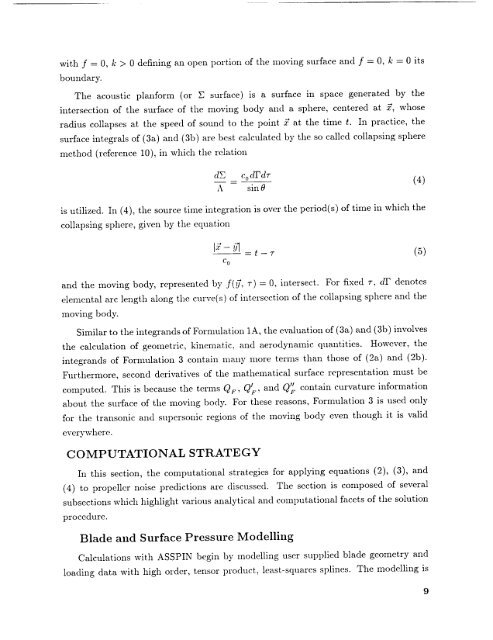Create successful ePaper yourself
Turn your PDF publications into a flip-book with our unique Google optimized e-Paper software.
with f = 0, k > 0 defining an open portion of the moving surface and f = 0, h = 0 itsboundary.The acoustic planform (or Z surface) is a surface in space generated by theintersection of the surface of the moving body and a sphere, centered at 2, whoseradius collapses at the speed of sound to the point J at the time t. In practice, thesurface integrals of (3a) and (3b) are best calculated by the so called collapsing spheremethod (reference 10), in which the relationdEc odr'drA sin 0(4)is utilized. In (4), the source time integration is over the period(s) of time in which thecollapsing sphere, given by the equationc 0(5)and the moving body, represented by f(_, r) = 0, intersect. For fixed T, dF denoteselemental arc length along the curve(s) of intersection of the collapsing sphere and themovingbody.Similar to the integrands of Fornmlation 1A, the evaluation of (3a) and (3b) involvesthe calculation of geometric, kinematic, and aerodynamic quantities. However, theintegrands of Formulation 3 contain many more terms than those of (2a) and (2b).Furthermore, second derivatives of the mathematical surface representation must becomputed. This is because the terms Qr, Q_, and Q_ contain curvature informationabout the surface of the moving body. For these reasons, Formulation 3 is used onlyfor the transonic and supersonic regions of the moving body even though it is valideverywhere.COMPUTATIONALSTRATEGYIn this section, the computational strategies for applying equations (2), (3), and(4) to propeller noise predictions are discussed. The section is composed of severalsubsections which highlight various analytical and computational facets of the solutionprocedure.Blade and Surface Pressure ModellingCalculations with <strong>ASSPIN</strong> begin by modelling user supplied blade geometry andloading data with high order, tensor product, least-squares splines. The modelling is9

















